GRADUATE
HERE WE GRADUATE!! WE OFFER BEST TUTORIAL SERVICES
- 236
- 0
- 1
Community
- Followers
- Following
17 Reviews received
237 items
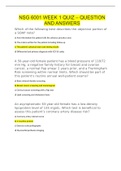
NSG 6001 WEEK 1 QUIZ – QUESTION AND ANSWERS
NSG 6001 WEEK 1 QUIZ – QUESTION AND ANSWERS Which of the following best describes the objective portion of a SOAP note? a) Any information the patient tells the advance practice nurse b) The orders written for the patient including follow up c) The patient’s physical exam and testing results d) Differential and primary diagnosis with ICD 10 codes A 50-year-old female patient has a blood pressure of 118/72 mm Hg, a negative family history for breast and ovarian cancer, a normal Pap sm...
- Exam (elaborations)
- • 2 pages •
NSG 6001 WEEK 1 QUIZ – QUESTION AND ANSWERS Which of the following best describes the objective portion of a SOAP note? a) Any information the patient tells the advance practice nurse b) The orders written for the patient including follow up c) The patient’s physical exam and testing results d) Differential and primary diagnosis with ICD 10 codes A 50-year-old female patient has a blood pressure of 118/72 mm Hg, a negative family history for breast and ovarian cancer, a normal Pap sm...
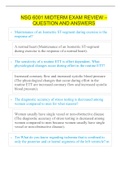
NSG 6001 MIDTERM EXAM REVIEW – QUESTION AND ANSWERS
NSG 6001 MIDTERM EXAM REVIEW – QUESTION AND ANSWERS • Maintenance of an Isometric ST-segment during exercise is the response of? A normal heart (Maintenance of an Isometric ST-segment during exercise is the response of a normal heart). • The sensitivity of a routine ETT is effort dependent. What physiological changes occur during effort in the routine ETT? Increased coronary flow and increased systolic blood pressure (The physiological changes that occur during effort in the routine ET...
- Exam (elaborations)
- • 11 pages •
NSG 6001 MIDTERM EXAM REVIEW – QUESTION AND ANSWERS • Maintenance of an Isometric ST-segment during exercise is the response of? A normal heart (Maintenance of an Isometric ST-segment during exercise is the response of a normal heart). • The sensitivity of a routine ETT is effort dependent. What physiological changes occur during effort in the routine ETT? Increased coronary flow and increased systolic blood pressure (The physiological changes that occur during effort in the routine ET...

NSG 6001 MIDTERM EXAM 2 – QUESTION AND ANSWERS
NSG 6001 MIDTERM EXAM 2 – QUESTION AND ANSWERS Question 1. Question : A 35 year old female arrives at your clinic. She has had diabetes and peripheral artery disease for the past 5 years. You decide to obtain an ETT. The insurance company argues that this is inappropriate. You justify the ETT because you are planning secondary strategies to prevent future heart disease. Where could one find the supporting data for these guidelines? Medicare guidelines xFramingham risk score (These ...
- Exam (elaborations)
- • 9 pages •
NSG 6001 MIDTERM EXAM 2 – QUESTION AND ANSWERS Question 1. Question : A 35 year old female arrives at your clinic. She has had diabetes and peripheral artery disease for the past 5 years. You decide to obtain an ETT. The insurance company argues that this is inappropriate. You justify the ETT because you are planning secondary strategies to prevent future heart disease. Where could one find the supporting data for these guidelines? Medicare guidelines xFramingham risk score (These ...
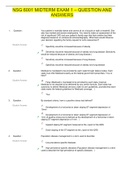
NSG 6001 MIDTERM EXAM 1 – QUESTION AND ANSWERS
NSG 6001 MIDTERM EXAM 1 – QUESTION AND ANSWERS 1. Question : Your patient is morbidly obese and cannot sit on a bicycle or walk a treadmill. She also has marked and severe emphysema. You need to make an assessment of the risk of significant CAD and your patient’s family says that their relative had their diagnosis based on an ultrasound echocardiography. What facts would influence your decision regarding the family request for echo assessment? Student Answer: Specificity would ...
- Exam (elaborations)
- • 8 pages •
NSG 6001 MIDTERM EXAM 1 – QUESTION AND ANSWERS 1. Question : Your patient is morbidly obese and cannot sit on a bicycle or walk a treadmill. She also has marked and severe emphysema. You need to make an assessment of the risk of significant CAD and your patient’s family says that their relative had their diagnosis based on an ultrasound echocardiography. What facts would influence your decision regarding the family request for echo assessment? Student Answer: Specificity would ...
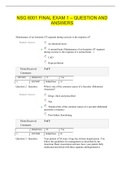
NSG 6001 FINAL EXAM 1 – QUESTION AND ANSWERS
NSG 6001 FINAL EXAM 1 – QUESTION AND ANSWERS Maintenance of an Isometric ST-segment during exercise is the response of? Student Answer: An abnormal heart A normal heart (Maintenance of an Isometric ST-segment during exercise is the response of a normal heart. ) CAD Hypo profusion Points Received: 5 of 5 Comments: Question 2. Question : What is one of the common causes of a Saccular Abdominal Aneurysm? Student Answer: Drugs: il...
- Exam (elaborations)
- • 49 pages •
NSG 6001 FINAL EXAM 1 – QUESTION AND ANSWERS Maintenance of an Isometric ST-segment during exercise is the response of? Student Answer: An abnormal heart A normal heart (Maintenance of an Isometric ST-segment during exercise is the response of a normal heart. ) CAD Hypo profusion Points Received: 5 of 5 Comments: Question 2. Question : What is one of the common causes of a Saccular Abdominal Aneurysm? Student Answer: Drugs: il...
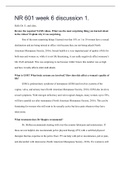
NR 601 week 6 discussion 1.
NR 601 week 6 discussion 1. Hello Dr. E. and class, Review the required NAMS videos. What was the most surprising thing you learned about in the videos? Explain why it was surprising. One of the most surprising things I learned was that 10% or 1 in 10 women have a sexual dysfunction and are being missed at office visit because they are not being asked (North American Menopause Society, 2016). Sexual health is a very important part of quality of life for both men and women so, while it is not...
- Exam (elaborations)
- • 4 pages •
NR 601 week 6 discussion 1. Hello Dr. E. and class, Review the required NAMS videos. What was the most surprising thing you learned about in the videos? Explain why it was surprising. One of the most surprising things I learned was that 10% or 1 in 10 women have a sexual dysfunction and are being missed at office visit because they are not being asked (North American Menopause Society, 2016). Sexual health is a very important part of quality of life for both men and women so, while it is not...
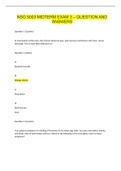
NSG 5003 MIDTERM EXAM 3 – QUESTION AND ANSWERS
NSG 5003 MIDTERM EXAM 3 – QUESTION AND ANSWERS Question 1 (2 points) In examination of the nose, the clinician observes gray, pale mucous membranes with clear, serous discharge. This is most likely indicative of: Question 1 options: a) Bacterial sinusitis b) Allergic rhinitis c) Drug abuse d) Skull fracture Save Question 2 (2 points) Your patient complains of a feeling of heaviness in the lower legs daily. You note varicosities, edema, and dusky color of b...
- Exam (elaborations)
- • 70 pages •
NSG 5003 MIDTERM EXAM 3 – QUESTION AND ANSWERS Question 1 (2 points) In examination of the nose, the clinician observes gray, pale mucous membranes with clear, serous discharge. This is most likely indicative of: Question 1 options: a) Bacterial sinusitis b) Allergic rhinitis c) Drug abuse d) Skull fracture Save Question 2 (2 points) Your patient complains of a feeling of heaviness in the lower legs daily. You note varicosities, edema, and dusky color of b...
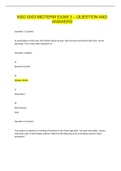
NSG 5003 MIDTERM EXAM 3 – QUESTION AND ANSWERS
NSG 5003 MIDTERM EXAM 3 – QUESTION AND ANSWERS Question 1 (2 points) In examination of the nose, the clinician observes gray, pale mucous membranes with clear, serous discharge. This is most likely indicative of: Question 1 options: a) Bacterial sinusitis b) Allergic rhinitis c) Drug abuse d) Skull fracture Save Question 2 (2 points) Your patient complains of a feeling of heaviness in the lower legs daily. You note varicosities, edema, and dusky color of b...
- Exam (elaborations)
- • 70 pages •
NSG 5003 MIDTERM EXAM 3 – QUESTION AND ANSWERS Question 1 (2 points) In examination of the nose, the clinician observes gray, pale mucous membranes with clear, serous discharge. This is most likely indicative of: Question 1 options: a) Bacterial sinusitis b) Allergic rhinitis c) Drug abuse d) Skull fracture Save Question 2 (2 points) Your patient complains of a feeling of heaviness in the lower legs daily. You note varicosities, edema, and dusky color of b...
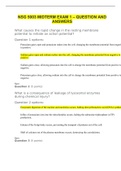
NSG 5003 MIDTERM EXAM 1 – QUESTION AND ANSWERS
NSG 5003 MIDTERM EXAM 1 – QUESTION AND ANSWERS What causes the rapid change in the resting membrane potential to initiate an action potential? Question 1 options: Potassium gates open and potassium rushes into the cell, changing the membrane potential from negative to positive Sodium gates open and sodium rushes into the cell, changing the membrane potential from negative to positive. Sodium gates close, allowing potassium into the cell to change the membrane potential from positiv...
- Exam (elaborations)
- • 17 pages •
NSG 5003 MIDTERM EXAM 1 – QUESTION AND ANSWERS What causes the rapid change in the resting membrane potential to initiate an action potential? Question 1 options: Potassium gates open and potassium rushes into the cell, changing the membrane potential from negative to positive Sodium gates open and sodium rushes into the cell, changing the membrane potential from negative to positive. Sodium gates close, allowing potassium into the cell to change the membrane potential from positiv...
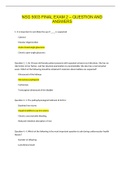
NSG 5003 FINAL EXAM 2 – QUESTION AND ANSWERS
NSG 5003 FINAL EXAM 2 – QUESTION AND ANSWERS 1. It is important to not dilate the eye if ____ is suspected. Cataract Macular degeneration Acute closed-angle glaucoma Chronic open-angle glaucoma Question 2. 2. An 18-year-old female patient presents with repeated urinary tract infections. She has no risk factors in her history, and her physical examination is unremarkable. She also has a normal pelvic exam. Which of the following should be obtained if anat...
- Exam (elaborations)
- • 53 pages •
NSG 5003 FINAL EXAM 2 – QUESTION AND ANSWERS 1. It is important to not dilate the eye if ____ is suspected. Cataract Macular degeneration Acute closed-angle glaucoma Chronic open-angle glaucoma Question 2. 2. An 18-year-old female patient presents with repeated urinary tract infections. She has no risk factors in her history, and her physical examination is unremarkable. She also has a normal pelvic exam. Which of the following should be obtained if anat...

MATH 225N FINAL EXAM 2 – QUESTION AND ANSWERS
INET HESI RN V1 ACTUAL TEST SCREENSHOTS
INET HESI RN V1 ACTUAL TEST SCREENSHOTS
INET HESI RN V1 ACTUAL TEST SCREENSHOTS
INET HESI RN V1 ACTUAL TEST SCREENSHOTS